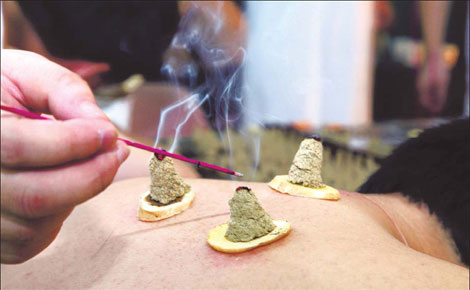
Sanfu - the hottest days of the year - is the only time to get a futie patch, which consists of medicinal herbs that are applied to specific acupuncture points to treat colds. Ashley Chen and Lin Qi report
As people around the country wilt in the heat, hospitals and clinics of traditional Chinese medicine (TCM) are seeing some of their busiest days of the year.In every hospital the front lobby is filled to capacity with people of all ages waiting for the treatment of futie ?a patch consisting of medicinal herbs that are applied to specific acupoints.
"This patch is used to treat diseases of a chronic and cold nature, often occurring or being worse in the winter," says Dr Wang Guangtao with Beijing Massage Hospital's sub-health treatment center.
Most of Wang's patients are those with respiratory diseases, like asthma, or those with weak constitutions who frequently have colds in winter, or those with chronic pain, such as arthritis.
The patch only works if one gets it during sanfu - the three periods of the hottest days of the year, usually in July and August, Wang stresses.
First noted in Inner Canon of the Yellow Emperor (Huangdi Neijing), the most important ancient book of Chinese medicine, this special practice has been used for ages. The use of the patch is based on restoring the balance of yin and yang in the body, which is vital for optimal health, according to Wang.
"In summer, we need to nourish the yang, while in winter nourish yin - one of the principals of TCM," Wang says.
The patch with warm and pungent herbs is used to disperse colds and transform phlegm, warm the lungs, boost the kidneys, and secure the flow of qi (energy), Wang explains.
"Futie treats the root of the disease rather than the branch, thereby eliminating the disease or preventing the symptoms before the winter arrives," Wang explains.
While receiving the treatment, one has to take a thorough examination and then the doctor will prescribe different patches for the patient. Each patch is filled with herbal paste and then is placed on specific acupuncture points on the back and on the chest. The paste and the acupoints may vary depending on the patient's specific need.
The cold and dry winter of Beijing has always caused Chen, 28, an office worker, a stuffy nose and dizziness. She was diagnosed with allergic rhinitis.
"The doctor of Western medicine had prescribed some liquid potion. But it didn't bring permanent relief," she says. "Then my aunt, whose asthma and rhinitis has been eased after years of TCM treatments, suggested I try traditional measures."
Chen has been receiving acupuncture and moxibustion therapies since last winter. Now she is using six patches four hours a day for two weeks at the sub-health treatment center.
"I need to wait until the winter to see if the patch works. But I feel it is a mild and environmental friendly practice. And I've recommended the patch to my colleagues who have similar symptoms," Chen says.
While using the patch, people need to attend to their bad habits, such as drinking, smoking, and not exercising enough, which may break the balance of yin and yang in the body, Wang says.
The use of this patch does not conflict with Western medicine, and patients may continue the use of any prescribed medications and vitamins.
The treatment does have some potential side effects. Some patients complain that from time to time their skin gets irritated due to the herbal paste, causing allergic reactions, hot skin, and itchiness.
Wang and his colleagues prefer not to use this patch for children due to their softer and more sensitive skin. Nevertheless, children aged over 3 can use the patch.
"This ages-old treatment is still popular to this day," Wang says, pointing out that his hospital treats about 2,000 people every year.
Back in the 1990s, the majority of the patients were aged above 50. Now the hospital sees an increasing number of young people, who mostly suffer from back pain caused by long hours of office work, as well as other discomforts caused by smoking, drinking and other bad habits, according to Wang.
Some children also use patches for shoulder and back problems, because they don't sit in a right position and indulge in computer games.
Yet, some are skeptical about the effectiveness of the treatment.
"It does help in preparing the body for winter, but to see the real affects of the patch, one would have to wait a few years," Wang says. "And chronic diseases will take a long time to treat. Therefore, patients should take the treatment for three to five consecutive years."
"I've been practicing for more than 25 years, and some of the therapies that I use don't always have a very good scientific explanation, but they work," says Mark Nolting, a senior acupuncturist and Western trained physician operating a clinic in Seattle, the United States.
